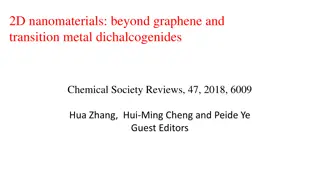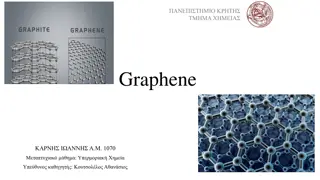Exploring the Fascinating World of Graphene: Recent Developments and Future Applications
Graphene, a single thin layer of graphite, has revolutionized the field of materials science since its discovery in 2004. This remarkable material, composed of tightly packed carbon atoms in a hexagonal pattern, possesses exceptional properties, including high electrical conductivity, mechanical strength, and thermal conductivity. With ongoing research leading to new developments and potential future applications in various fields, graphene continues to captivate scientists and engineers worldwide.
Download Presentation

Please find below an Image/Link to download the presentation.
The content on the website is provided AS IS for your information and personal use only. It may not be sold, licensed, or shared on other websites without obtaining consent from the author. Download presentation by click this link. If you encounter any issues during the download, it is possible that the publisher has removed the file from their server.
E N D
Presentation Transcript
Graphene recent developments
Outline Introduction History Structure Properties Application in Various Fields Advantages and Limitations Recent developments Future Applications Conclusion
introduction What is Graphene? Graphene is a single thin layer of graphite It is an allotrope of carbon It is tightly packed layer of carbon atoms Its Atoms are arranged in a hexagonal pattern and resembles that of a honeycomb lattice It is one atom thick and the thinnest material known to man First 2D material ever discovered
history Graphene has been a known quantity for a long period of time Originally viewed under microscopes in 1962 and wasn t studied further The first isolated layer was discovered in 2004 by Andre Geim and Konstantin Novosolev at the University of Manchester This discovery won the Nobel prize in 2010 for ground breaking experiments regarding 2D graphene
history The tool used was a simple piece of scotch tape and it was done while using tape to polish a large block of graphite
properties Physical properties Density is 0.77mg/m Thinnest material possible, with 1 square meter coming in at around 0.77 milligrams Optical transparency Electrical properties High electrical conductivity; Best known conductor of electricity The conductivity is further increased by applying an electric field The electrical conductivity of graphene sheets are 10x that of copper
Properties Mechanical properties Strongest material ever tested; about a 1000x stronger than steel Bulk strength is 130GPa Thermal properties At room temperature, the thermal conductivity of graphene is very high
Properties Electronic properties Graphene has a remarkable high electron mobility at room temperature. The resistivity of graphene sheet would be 10 6 -cm Differs from normal 3dimensional materials Optical properties Has an abnormally high opacity for an atomic monolayer Caused by the unusual low energy electronic structure of monolayer graphene
Applications in various fields There exists already a plethora of applications of graphene. Some of them are; Integrated circuits Graphene has a high carrier mobility as well as low noise, allowing it to be used as the channel in a field effect transistor Processors use 100 GHz transistors on 2-inch (51mm) graphene sheets Graphene sheets can be used for transistors with Terahertz-speed transistors Graphene based IC s handles frequencies up to 10GHz
Applications Optical Electronics Graphene s high electrical conductivity and high optical transparency makes it a suitable candidate for transparent conducting electrodes Highly tensile and flexible Thus making it very suitable for optoelectronic applications; touchscreens, LCD s, organic photovoltaic cells etc
applications Filters Desalination-by very precise control over the size of holes in the graphene sheet, graphene oxide filters could outperform other filtration techniques Ethanol distillation-graphene oxide membranes allow water vapour to pass through but are impermeable to other liquids and gases
Applications Solar sells Graphene turns out to be a very good material for photo electrochemical energy conversion in dye sensitive solar cells These graphene films exhibit a high conductivity of 550 S/cm and a transparency of more than 70% over 1000-3000nm
Applications Energy Storage devices In the conductive plates of superconductors, graphene is used due to its extremely high surface area to mass ratio Graphene could also be used to produce super capacitors with a greater energy storage density than is currently available In initial tests carried out, laser-scribed graphene (LSG) supercapacitors (with graphene being the most electronically conductive material known, at 1738 siemens per meter (compared to 100 SI/m for activated carbon)), were shown to offer power density comparable to that of high-power lithium-ion batteries that are in use today.
biomedical Graphene cuould be used in the analysis of DNA at a much faster pace. This is done by sending the DNA molecule through a tiny slit in a graphene sheet. In 2010, it was found out that sheets of graphene oxide are highly effective at killing bacteria Which means that it could be useful in hygiene products or packaging that will help keep food fresh for longer periods of time
Limitations high-quality graphene is a great conductor that does not have a band gap (it can t be switched off). Graphene is extremely expensive to mass produce when large sheets of graphene are produced, there is an increased risk of tiny fissures and other flaws appearing in the material.
Recent developments Solar panels that turn rain drops to power technology combines an electron-enriched graphene electrode with a dye-sensitized solar cell. The new solar cell can be excited by incident light on sunny days and raindrops on rainy days by using a thin layer of highly conductive graphene, the solar cell could effectively harness power from rain. The salt contained in rain separates into ions (ammonium, calcium and sodium), making graphene and natural water a great combination for creating energy, The water actually clings to the graphene, forming a dual layer (AKA pseudocapacitor) with the graphene electrons. The energy difference between these layers is so strong that it generates electricity.
Recent developments Graphene Coating Improves Copper Nanowires for Use in Flexible Electronics Graphene Looks to Play a Role in Spintronics Graphene Makes Possible the First Textile Electrode As a replacement for kevlar for protective clothing
Future implications Lower cost of display screens in mobile devices. Lithium-ion batteries that recharge faster. Ultra capacitors with better performance than batteries. Components with higher strength to weight ratios. Storing hydrogen for fuel cell powered cars. Lower cost fuel cells. Low cost water of desalination: Lightweight natural gas tanks: More efficient dye sensitized solar cells. Electrodes with very high surface area and very low electrical resistance. Lower cost solar cells: Transistors that operate at higher frequency. Sensors to diagnose diseases. Membranes for more efficient separation of gases. Chemical sensors effective at detecting explosives.
conclusion Graphene without a doubt is one of the biggest discoveries of this centuries. Though limited by technological constraints and means of mass production, I believe that graphene with its almost mythical but vast qualities would be the next big thing in engineering and general applications
Thanks Questions?























